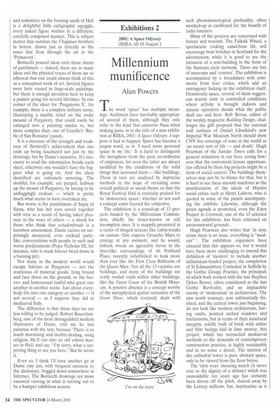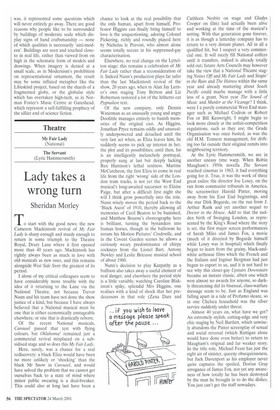Exhibitions 2
2001: A Space Odyssey (RIBA. till 18 August )
Millennium munificence
Alan Powers
The word 'space' has multiple meanings. Architects have inevitably appropriated several of them, although they only refer to the kind that concerns Nasa when making puns, as in the title of a new exhibition at RIBA, 2001: A Space Odyssey. I suppose it had to happen. Space has become a jargon word, as in 'I need more personal space in my life.' It is hard to distinguish the metaphors from the pure co-ordinates of emptiness, for even the latter are always modified by the conditions of the solid things that surround them — like buildings. These in turn are analysed by imprecise methods in the hope of revealing some overall political or social theme so that the Royal Festival Hall is routinely praised for its 'democratic space', whether or not such a concept exists beyond the subjective.
The exhibition is a round-up of 13 projects funded by the Millennium Commission, chiefly the lesser-known or still incomplete ones. It is snappily presented in a series of hinged screens like cabin-trunks on castors. One expects Groucho Marx to emerge at any moment, and he would, indeed, wreak an agreeable havoc in the liner-like surroundings of 66 Portland Place, recently refurbished to look more than ever like the First Class Ballroom of the Queen Mary. Not all the 13 varieties are buildings, and many of the buildings are really roofed voids within other buildings, like the Great Court of the British Museum. A positive absence is a concept worthy of the metaphysical spatial semantics of the Goon Show, which routinely dealt with
such phenomenological profundity, often mocked-up in cardboard for the benefit of radio listeners.
Many of the projects are concerned with leisure and tourism. The Falkirk Wheel, a spectacular rocking canal-boat lift, will encourage boat holidays in Scotland for the adventurous, while it is good to see the inclusion of a non-building in the form of the Sustrans cycle network. There are lots of museums and 'centres'. The exhibition is accompanied by a broadsheet with comments from four critics, which add an astringency lacking in the exhibition itself. Democratic space, several of them suggest, can scarely exist in controlled conditions where activity is brought indoors and unseen operators decide what the public shall see and hear. Rob Bevan, editor of the weekly magazine Building Design, challenges the glib proposal that the external wall surfaces of Daniel Libeskind's new Imperial War Museum North should show CNN live coverage of wars in the world as 'an ersatz sort of life — and death'. Hugh Pearman of the Sunday Times calls for a general relaxation in our lives, seeing however that the convenient leisure opportunities offered by these big projects might be a form of social control. The buildings themselves may not be to blame for that, but it is hard to see these smooth machines as the manifestation of the ideals of Marxist social critics such as Henri Lefevre, who is quoted in some of the panels accompanying the exhibits. Likewise, although the green agenda is promoted, even the Eden Project in Cornwall, one of the 13 selected for this exhibition, has been criticised on environmental grounds.
Hugh Pearman also writes that 'in style terms there is no issue, everything is "modern" '. The exhibition organisers have ensured that this appears so, but it would have been more challenging to extend this definition of 'modern' to include another millennium-funded project, the completion of St Edmundsbury Cathedral in Suffolk by the Gothic Design Practice, the principals of which both worked with the late Stephen Dykes Bower, often considered as the last Gothic Revivalist, and an implacable enemy of 'modernism' in architecture. The new north transept, now substantially finished, and the central tower just beginning, do not look like modern architecture, having vaults, pointed arched windows and battlements, but in terms of their structural integrity, solidly built of brick with ashlar and flint facings laid in lime mortar, this project, which has reconciled mediaeval methods to the demands of contemporary construction practice, is highly sustainable and in no sense a deceit. The interior of the cathedral tower is pure abstract space, only to be viewed from the floor below.
The 'style wars' shouting match (it never rose to the dignity of a debate) which was unavoidable ten years ago has certainly been driven off the pitch, sluiced away by the Lottery millions, but, inarticulate as it
was, it represented some questions which will never entirely go away. There are good reasons why people like to be surrounded by buildings of moderate scale which display signs of hand craftsmanship — none of which qualities is necessarily 'anti-modern'. Buildings are seen and touched closeto in real life, rather than viewed from on high in the schematic form of models and drawings. When imagery is denied at a small scale, as in Modernism's prohibition on representational ornament, the result may be some inflated metaphor like the Libeskind project, based on the shards of a fragmented globe, or the globular style which has overtaken high-tech, as in Norman Foster's Music Centre at Gateshead, which represent a self-fulfilling prophecy of the sillier end of science fiction.















































































 Previous page
Previous page